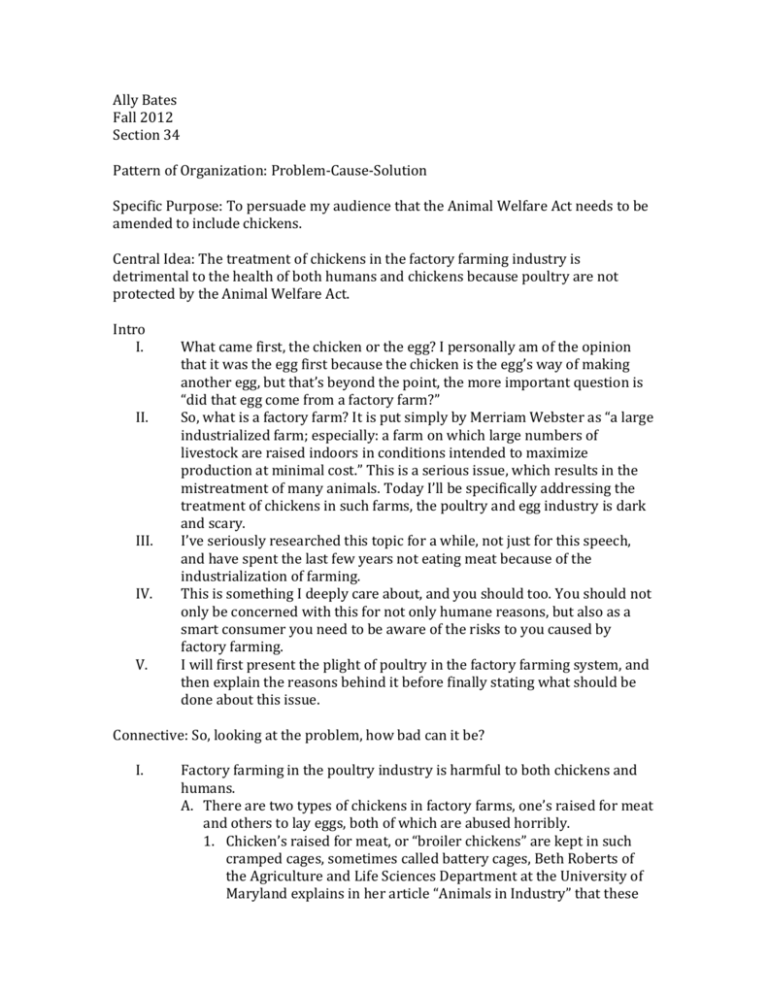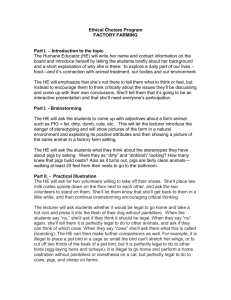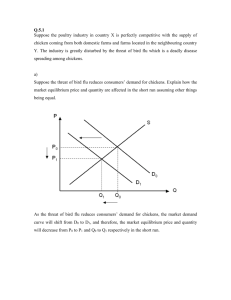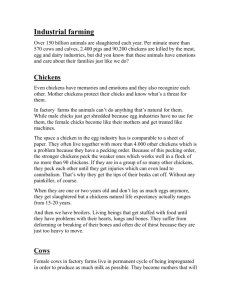Persuasive speech
advertisement

Ally Bates Fall 2012 Section 34 Pattern of Organization: Problem-­‐Cause-­‐Solution Specific Purpose: To persuade my audience that the Animal Welfare Act needs to be amended to include chickens. Central Idea: The treatment of chickens in the factory farming industry is detrimental to the health of both humans and chickens because poultry are not protected by the Animal Welfare Act. Intro I. What came first, the chicken or the egg? I personally am of the opinion that it was the egg first because the chicken is the egg’s way of making another egg, but that’s beyond the point, the more important question is “did that egg come from a factory farm?” II. So, what is a factory farm? It is put simply by Merriam Webster as “a large industrialized farm; especially: a farm on which large numbers of livestock are raised indoors in conditions intended to maximize production at minimal cost.” This is a serious issue, which results in the mistreatment of many animals. Today I’ll be specifically addressing the treatment of chickens in such farms, the poultry and egg industry is dark and scary. III. I’ve seriously researched this topic for a while, not just for this speech, and have spent the last few years not eating meat because of the industrialization of farming. IV. This is something I deeply care about, and you should too. You should not only be concerned with this for not only humane reasons, but also as a smart consumer you need to be aware of the risks to you caused by factory farming. V. I will first present the plight of poultry in the factory farming system, and then explain the reasons behind it before finally stating what should be done about this issue. Connective: So, looking at the problem, how bad can it be? I. Factory farming in the poultry industry is harmful to both chickens and humans. A. There are two types of chickens in factory farms, one’s raised for meat and others to lay eggs, both of which are abused horribly. 1. Chicken’s raised for meat, or “broiler chickens” are kept in such cramped cages, sometimes called battery cages, Beth Roberts of the Agriculture and Life Sciences Department at the University of Maryland explains in her article “Animals in Industry” that these are so small that they cannot spread their wings, or even turn around, this causes them to be stressed. 2. When chickens are under stress a typical behavioral tendency is for them to peck one another and occasionally cannibalize one another, so according to the Humane Farming Association their upper beaks are painfully removed with a hot knife to stop this. 3. Egg-­‐laying chickens suffer a similar fate, and unfortunately since male chicks are unneeded for the production of unfertilized eggs they are simply discarded, thrown into a dumpster or ground up to be put in fertilizer or chicken feed, this is explained in Becky Johnson’s article “Farm Sanctuary” in the “Journal of Agriculture and Food Information”. 4. It is often questioned whether or not non-­‐human animals can feel distress, and suffer, in “Animal Pleasure and it’s Moral Significance” Jonathan Balcombe explains how this is a very well-­‐ researched issue and it has been concluded that animals do feel pain and distress. B. Factory farming also has some serious consequences for human health as well. 1. Factory farms have massive numbers of animals on them, which allows it to be a breeding ground for disease, food-­‐borne illnesses are a serious issue, according to the Centers for Disease control and Prevention approximately 48 million Americans get a food-­‐ borne illness each year, and having massive often unsanitary farms is not helping. 2. For example, I’m sure many of you remember two years ago when a farm here in Iowa had to recall 380 million eggs from over 50,000 hens on one farm when they caused an outbreak in salmonella, according to William Neuman’s article “Egg Recall Expands after Salmonella Outbreak” in the New York Times. In this case this was caused by the company that owned these farms regularly not following regulations set up by the FDA. Connective: Now that we’ve looked at what is going on in this industry, why is it this way? II. This is really a problem due to firstly greed, and also the Animal Welfare Act. A. To put it simply, it’s cheaper to produce meat and eggs this way it’s even in the very definition of factory farming that I used at the beginning, and for many owners of these industrial farms the bottom line is only what matters. B. The reason people are allowed to treat chickens this way is sadly because of the Animal Welfare Act, which, taking clues from it’s name, is supposed to protect our little critter friends, except not all of them. 1. The Animal Welfare Act was first passed in 1966, and has since been amended multiple times, with it’s most recent amendment having happened in 2008. 2. This Law does a lot to protect a wide variety of animals, from livestock, to domestic pets; it outlaws dog fighting and all that great stuff. 3. Unfortunately though, in the text of the Animal Welfare Act’s 1970 amendment it explains what they mean in by the use of the term “animal” but it states that “such term excludes horses not used for research purposes and other farm animals, such as but not limited to livestock or poultry used or intended for use for improving animal nutrition, breeding, management, or production efficiency, or for improving the quality of food or fiber” basically saying that food-­‐producing animals, including chickens, are not being protected in this law. Connective: This law doesn’t do what it needs to do; there are some changes that need to be made. III. We need to change some things. A. Congress needs to amend the Animal Welfare Act so that poultry and other farm animals can receive the same care and rights as other animals, the exception in this law needs to be eradicated. 1. The Animal Welfare Act has been amended before, and is rather contradictory to it’s purpose if it excludes entire types of animals. 2. Loopholes in laws like this show real corruption in the system, like in New Zealand, which had been commended for it’s animal welfare laws until in 2009, according to Michael C. Morris in his article “The Use of Animals in New Zealand,” it was exposed that these welfare laws didn’t really protect the animals that need protection, which is very similar to what is happening here. B. As consumers you can be careful and check where your chicken and eggs come from and try to avoid industrial farm products, but I must warn you that even some poultry and eggs that claim to be “free-­‐ range” are not much better than factory farms as explained in “Animals in Industry.” C. Now, admittedly, the end, or at least the limiting, of factory farms will drive up the price of meat, eggs, and other animal byproducts, which I know sucks, but even if you couldn’t care less about animal rights are you willing to risk your health for cheap eggs? Connective: As you can see, we need to have legislation to protect poultry, and we can also be careful as to what we are buying. Conclusion I. II. III. So in the end we really need to look at ourselves and ask, “Am I willing to let an innumerable amount of living beings suffer for another person’s monetary gain?” Factory farming is a harmful industry, which treats living beings, our fellow animals, as simply a means of capitol gain, chickens are specifically excluded from legislation that should protect them, so they are abused in ways somewhat reminiscent of medieval torture. I don’t want to be a total downer, but I have to point out that all of this is humanity’s doing, but I also believe in the goodness of humanity and I believe that we as a species can overcome our own misdeeds, realize we are not alone in being able to suffer and fix this problem but to quote the great Dr. Seuss “Unless someone like you cares a whole awful lot, Nothing is going to get better. It's not.” Works Cited "Animal Welfare Act." Home. N.p., n.d. Web. 28 Oct. 2012. <http://awic.nal.usda.gov/government-­‐and-­‐professional-­‐resources/federal-­‐ laws/animal-­‐welfare-­‐act>. Balcombe, Jonathan. "Animal Pleasure and It's Moral Significance." Applied Animal Behavior Science 118 (2009): 208-­‐16. Print. Centers for Disease Control and Prevention. Centers for Disease Control and Prevention, 11 June 2012. Web. 28 Oct. 2012. <http://www.cdc.gov/foodborneburden/>. "Egg Industry." HFA: |Eggribusiness. N.p., 2011. Web. 28 Oct. 2012. <http://www.hfa.org/eggIndustry.html>. Johnson, Becky M. "Farm Sanctuary." Journal of Agriculture and Food Information 10.1 (2009): 81-­‐86. Print. Morris, Michael C. "The Use of Animals in New Zealand: Regulation and Practice." Society and Animals 19 (2011): 368-­‐82. Print. Neuman, William. "Egg Recall Expanded After Salmonella Outbreak." New York Times 19 Aug. 2010: B1. Print. Roberts, Beth, MLS. "Animals in Industry." The Reference Librarian 41.86 (2004): 71-­‐ 79. Print. Webster, Noah. "Factory Farm." New Collegiate Dictionary. A Merriam-­‐Webster. 1953. Print.






